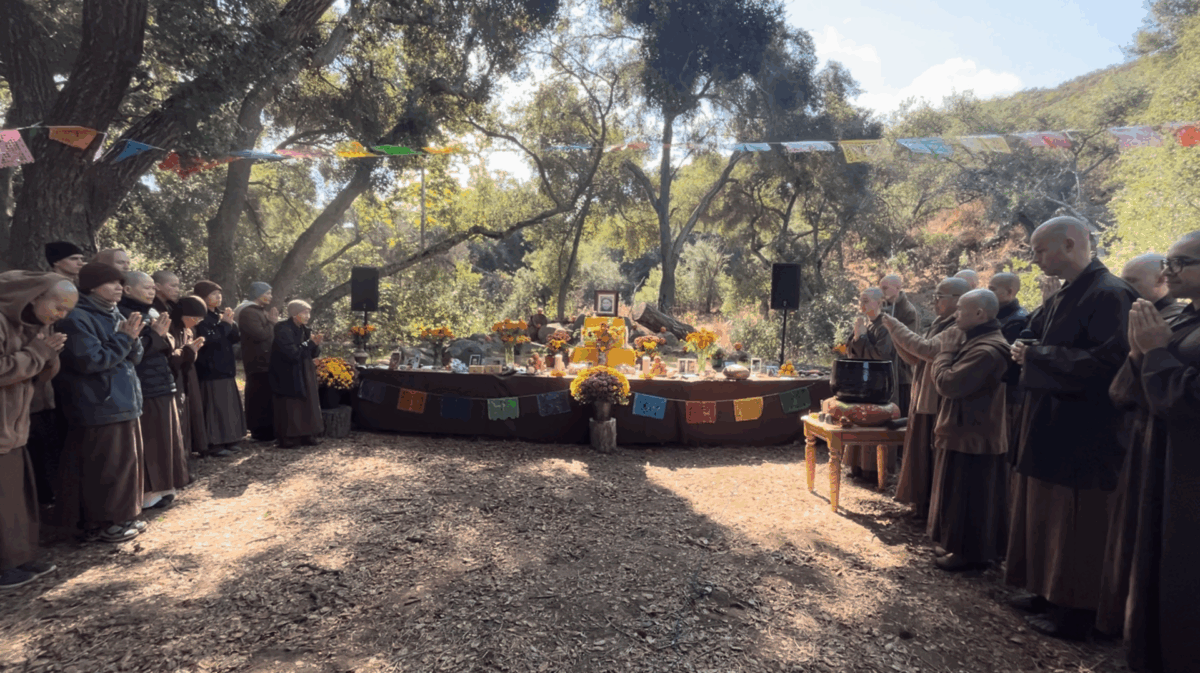Thầy offers us self-care practices to be with our loved ones who have passed.
By Thich Nhat Hanh on
Seeing Your Loved One within You
When someone we love passes away, we may suddenly feel abandoned or alone and may believe that we have lost them forever. We may experience anguish and feel disconnected from them. However, when we reconnect with ourselves,
Thầy offers us self-care practices to be with our loved ones who have passed.
By Thich Nhat Hanh on
Seeing Your Loved One within You
When someone we love passes away, we may suddenly feel abandoned or alone and may believe that we have lost them forever. We may experience anguish and feel disconnected from them. However, when we reconnect with ourselves, we reconnect with our loved one, with our ancestors, and with the whole stream of life. When we come home to ourselves, we can touch our loved one within us.
Our parents are our closest ancestors. We know that, genetically speaking, all our ancestors are still alive in each of our cells. They have not died. But not only do we carry their genes, we also carry all their thoughts, beliefs, experiences, and aspirations within us. We carry their actions of body, speech, and mind into the future. You cannot take your loved one out of you, just as you cannot take your father or your mother out of you, even if you wanted to. Everything is in everything else. With the insight of interconnectedness or “interbeing,” you understand that you are your father, you are your mother. If you are angry with your father or your mother, you are angry with yourself. Likewise, if you are angry with your children, you are angry with yourself. Our children are our continuation, and they carry us into the future.
The same is true with our loved one. Even if we are not related biologically, they are in us and it is impossible to take them out. All our shared experiences and everything they have ever thought, said, or done, lives on within us and cannot be undone or taken out of us. To reconnect with them, we only need to go inward and reconnect with ourselves.
This short guided meditation can help us visualize the reality of our loved ones within us. We can also substitute with the words “mother,” “father,” “grandmother,” “grandfather,” and “all my ancestors” in order to feel the connection to all our ancestors in us and to receive their energy and support.
Breathing in, I see the presence of my beloved in every cell of my body.
Breathing out, I smile to my beloved in every cell of my body.
My beloved in every cell,
Smiling.
Breathing in, my loved one is breathing in with me.
Breathing out, my loved one is breathing out with me.
My loved one breathing in with me
My loved one breathing out with me
Breathing in, I am breathing with my loved one’s lungs.
Breathing out, our bodies relax.
Breathing with my loved one’s lungs,
Our bodies relaxing.
Breathing in, I am looking with my loved one’s eyes.
Breathing out, I am listening with my loved one’s ears.
Looking with my loved one’s eyes
Listening with my loved one’s ears
Breathing in, I see I am part of the wonderful river of life, flowing continuously for thousands of years.
Breathing out, I smile and entrust myself to this river of life.
River of life, entrusting myself.

Making an Altar for Your Loved One
When we have lost someone we love, we often feel the need to express our deep love and gratitude to them. We want to offer them something. And we want to keep their memory alive.
Making a shrine or altar for our loved one at home is a concrete way of expressing our love and care, and of helping us feel connected to them. We can set up a small table and place a photograph of our loved one, a candle, some flowers, and other meaningful things on it. We may like to include items representing our spiritual tradition if we have one, or things collected in nature—perhaps a stone, a leaf, a shell, or a flower. You may also like to place something on the altar that had special meaning for your loved one.
To help us feel connected and maintain communication, we can write to our loved one—a note, a love letter, an appreciation, or an apology—and put it on the altar. Some people like to light a candle, or offer incense, flowers, or their loved one’s favorite food. On special days, such as ceremonial days during the initial period of mourning, on your loved one’s birthday, or the anniversary of their death, we can prepare our loved one’s favorite dishes or treats and place them on the altar. After the ceremony, everyone can enjoy eating them together, creating a feeling of intimacy and joy.
o o o
Placing objects on an altar doesn’t mean we’re worshiping these things. Creating and maintaining a home altar is a way to pay respect and express our love and gratitude to our loved one, our ancestors, and the world around us. It helps us remember that whatever we love, respect, and care deeply about is also within us.
Keep the altar fresh and beautiful, cleaning it and tending to it every day with mindfulness, love, and concentration. This helps us maintain our connection to our loved one. We can speak to them and tell them everything that is going on for us. We can announce all the news to our loved one, and to all our ancestors at the same time. We may like to tell our loved one that whatever they may not have finished or healed in their lifetime, we are doing our best to accomplish for them. This is the way to establish deep ongoing connections with our loved one and with the stream of life of which we are a part.

These are excerpts from How to Live When a Loved One Dies: Healing Meditations for Grief and Loss by Thích Nhất Hạnh.


